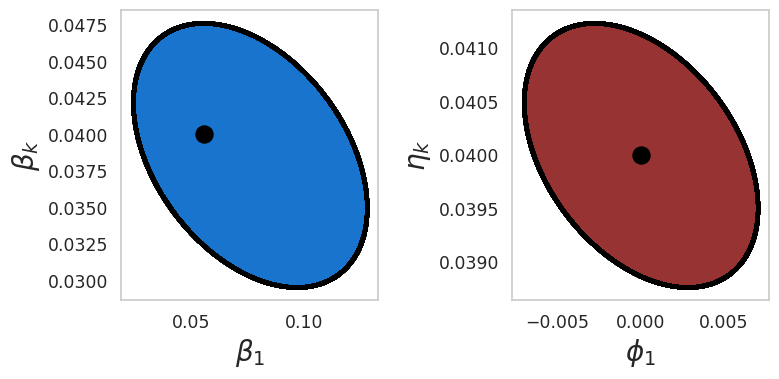2 Ambiguity Sets#
This Python notebook covers how to produce the ambiguity sets (Figure 4 in the main paper). Recall the restriction from Chapter 1.3 of the notebook:
Where:
Substituting \(H_t\) into the first equation:
By fixing \((\omega,q)\), we trace out a set of parametric models with the same relative entropy. Specifically, we trace out a contour set for \(\eta_0,\eta_1\) which in turn allows us to trace out a set of values for \(\alpha_k,\beta_k,\alpha_z,\beta_z\). Following Hansen and Sargent (2020), for ambiguity over the slope parameters only, we set:
For ambiguity over slope and constant parameters, we set:
Thus we need to specify the following inputs:
Input |
Notation in paper |
Description |
Parameter used in paper |
|---|---|---|---|
|
\(\beta_1\) |
Persistence of \(Z_1\) |
0.056 |
|
\(\mu_1\) |
Drift of \(Z_1\) |
0.0 |
|
\(\eta\) |
Depreciation |
-0.04 |
|
\(\beta_k\) |
Loading factor on the capital stock in the long run risk process |
0.04 |
|
\(q\) |
Relative entropy constraint |
|
|
|
We can then import the necessary libraries and set the inputs:
import os
import sys
import numpy as np
np.set_printoptions(suppress=True, linewidth=200)
import matplotlib.pyplot as plt
import seaborn as sns
sns.set(style="whitegrid", font_scale=1.13, rc={"lines.linewidth": 3.5})
plt.rcParams['axes.formatter.useoffset'] = True
from scipy.optimize import bisect
os.chdir("src/2")
from ambiguity_sets import main
os.chdir("../..")
For our example, we extend ambiguity to all four parameters and set \(q=0.2\).
baseline_beta_z = 0.056
baseline_alpha_z = 0.0
baseline_eta = 0.04
baseline_beta_k = 0.04
q = 0.2
twoparameter = 0
We can now run the main function:
ambiguity_set = main(baseline_beta_z,baseline_alpha_z,baseline_eta,baseline_beta_k,q,twoparameter)
rho_2 for all four parameters = 8.14251352878623
We plot the results here:
fig, ax = plt.subplots(1, 2, figsize=(8, 4))
# First subplot
contour, alpha_zs, alpha_ks, beta_zs, beta_ks = ambiguity_set
plt.subplot(1, 2, 1)
plt.fill(beta_zs, beta_ks, color='#1874CD', linewidth=2)
plt.ylabel('$\\beta_k$', fontsize='20')
plt.xlabel('$\\beta_1$', fontsize='20')
plt.scatter(beta_zs, beta_ks, color='black', s=4)
plt.scatter(baseline_beta_z, baseline_beta_k, color='black', s=150)
plt.grid(False)
# Second subplot
plt.subplot(1, 2, 2)
plt.fill(alpha_zs, alpha_ks, color='#983333', linewidth=2)
plt.ylabel('$\\eta_k$', fontsize='20')
plt.xlabel('$\\phi_1$', fontsize='20')
plt.scatter(alpha_zs, alpha_ks, color='black', s=4)
plt.scatter(baseline_alpha_z, baseline_eta, color='black', s=150)
plt.grid(False)
plt.tight_layout()
